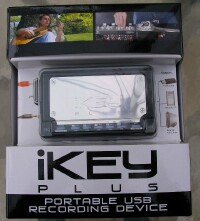
Note: click any picture in this review to view it full-sized in a new window
Last Summer I reviewed GCI Technology's first generation iKEY Portable USB Recorder.
This innovative little device, about the size of a paperback book, took analog line input from virtually any audio source with line-out jacks or a headphone jack, processed the audio in real-time, on-the-fly and converted and wrote it to MP3 files in your choice of three different levels of compression, or straight, uncompressed WAV files, directly to any USB storage device connected to it thumb drive, hard drive, iPod, or any similar widget you can plug into the iKEY's USB port.
To say I was smitten with the original iKEY would be an understatement. I'd been waiting for a tool like this for years. What this little white box let me do was convert my prized analog recordings into modern, digital MP3 files.
Tape recordings are not forever no matter what format, it's a fragile media that's not only affected by stray magnetic fields, but by its very physical nature, (oxide particles on a Mylar base).. after many years it starts to self-destruct until eventually, it's useless and the recordings on it are gone forever.
I also have a closet full of albums, EPs and singles (I lost count at about two thousand), ranging from shellac 78s my folks bought in the 40s and 50s, to my own childhood, high school and college years vinyl of all description, and many of them have become rare and quite valuable over the years, plus a huge collection of old cassettes, some of which were air-check tapes of shows I did back in the early 70s during a stint as a DJ at a local radio station. Plus there were other tapes in different formats I'd acquired over many years that held tremendous sentimental value to me "letters on tape" from relatives, a recording of my late Dad's retirement dinner from 1980, even messages on cassette back before I bought a digital answering machine for my home phone.
With the iKEY, I could convert these analog recordings, no matter what kind of media they were on, into MP3 files, so I could preserve my originals, and have fresh, digital versions to play on my laptop, or on my Treos.
Vinyl is back
In case you haven't noticed, there's a vinyl renaissance going on original pressings of many records have and continue to increase in value. All you have to do is look at eBay, check some price guides, and see how much collectors are paying for rare, and even not so rare records, or obscure records. And if you already own a recording, why shell out the money to re-buy your music on audio CDs, or pay to download heavily DRMd tracks that require specially-coded players if you already own that same music on vinyl or tapes?
Companies like Music Direct sell thousands of new releases on vinyl, much of it re-mastered, very high end audiophile quality too.
So to me, the iKEY was a Baby Boomer's dream come true. The beauty of the iKEY is that it was totally free-standing and self-contained, meaning no computer or software required to use it. Just hook it up to your stereo or tape deck with a single cable, plug a USB storage device into it, press a couple of buttons and blammo, instant MP3 files ready to transfer to your computer, or even use it to record directly to an SD card and play the resulting files on your Treo or any other MP3-capable device you own.
Well the original iKEY was just too cool, and although it did exactly what its mfr claimed, it was lacking a few features that would have made it an even more awesome and versatile contraption.
GCI Technologies, makers of the iKEY, listened to customer input (I gave them plenty myself) suggestions for additional features that owners of the original iKEY wanted in a next-gen device, and the new iKEY Plus delivers just about everything the original version's owners begged for.
Overview
The iKEY Plus comes out of its impressive packaging with a LOT of accessories illustrated in this shot:
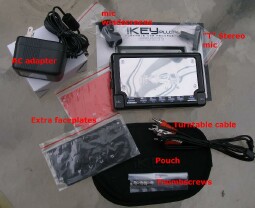
Open the box and out tumbles:
The sexy black iKEY Plus
A multi-language owner's manual that, while printed in tiny type, covers everything you'll need to know to get up to speed quickly
A soft carrying pouch
A small, T-shaped stereo mic
A pair of foam windscreens for the mic
An AC wall wart
Three different metal faceplates so you can change its appearance in seconds depending on if you prefer shiny chrome, red, or the black on black look
A quartet of thumbscrews which replace the Philips-head faceplate screws (both iKEYs will run off AC or battery power, and hold and charge four AA NiMH rechargeable batteries which live in a compartment beneath the faceplate the thumbscrews make removing the plate a simple, tool-free task)..
A turntable connection cable with ground-lug for direct hookup of any turntable
Changes and improvements
I'll show you some side-by-side comparison shots of the original iKEY and the new iKEY plus and you'll easily see what's the same and what's changed. But if it's not obvious, here's an illustrated tour around the old and the new, and I'll point out the differences along the way:
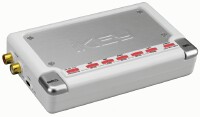
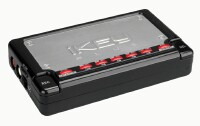
The casework of both iKEYs is 99% identical in size, shape, and weight (about 9 oz. with batteries inside, about 5 oz. without them). The original was white, the Plus is black.


Left side the original featured a pair of Gold-plated stereo line-input jacks, and a rotary recording level wheel. The Plus has the same two input jacks, but now they're recessed into the plastic body. The recording level dial is identical on the Plus but it's been moved up. Below it is a three-position slide switch.
With this switch you select either "LN" - line-level input (such as from the headphone jack of a receiver, tape deck, laptop, whatever), or "PH" the Plus has a built-in phono pre-amp, so you can connect a turntable directly to it, completely bypassing the need to use a turntable connected to a stereo system's receiver or pre-amp.
An aside here. Those of you who still play records or own older or "vintage" HiFi gear know that the output of a turntable's cartridge is an infinitesimally small signal it needs to be pre-amplified before it reaches a stereo's main amplifier. Older stereo receivers had phono pre-amps built into them for that purpose. Most contemporary consumer-grade HiFi gear lacks a built-in turntable pre-amp because, let's face it, most people just don't buy vinyl any more, so they don't own turntables, so HiFi mfrs cut cost by leaving the phono pre-amp stage out of their receivers. The iKEY Plus' built-in phono pre-amp lets you connect a turntable directly to it without the need to purchase a separate outboard pre-amp.
Finally, the "MIC" position of the slide switch lets you plug a mic with a 3.5mm (1/4 inch) standard mini-plug directly into the iKEY Plus via the jack directly to the right of the slider. A small, "T"-shaped stereo mic with foam windscreens is included in the Plus' box. The Plus also has new, built-in circuitry to amplify any mic's signal, so if you have or want to use a higher-quality mic, just plug'er right in.
Unfortunately, the three-way slide switch limits you to one kind of input at a time line input, turntable, or mic. And the rotary "REC LEVEL" wheel, like its predecessor, still has no markings or detents on it. So it's impossible to tell where between minimum and maximum level it's set just by looking at it, but much better visual level metering is a new feature of the Plus and I'll get to that shortly.


Right side
Not as many changes here, as you can see from the side-by-side photos of the old and the new, but hooray, they've added a stereo headphone jack to the iKEY Plus. Now you can monitor your recordings, AS you make them, without the need to cable the iKEY Plus to a full stereo rig with speakers. This is a huge improvement and means if you're using the Plus out in the field on battery power, you can hear your recording level and adjust it, if it's two low or too high just by plugging in any decent pair of cans. The Reset button is also easier to get to not as deeply recessed as it was on the original iKEY.
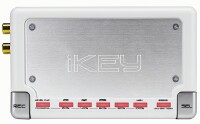
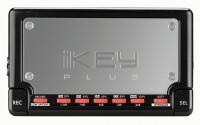
Top side
The top of the iKEY, both models, is its "dashboard" and there are huge improvements here. Compare the original with the Plus.
They've added a fourth level of MP3 encoding, so in addition to 128kbps, 192kbps, 256kbps, you now have 320kbps. The higher the number, the less compression, the higher the quality, and the bigger the resulting file size of your MP3 recordings. 128kbps is about equal to FM radio quality. 320kbps is virtually the same quality as an Audio CD. The two middle numbers are "better than FM but not quite as good as Audio CD." Plus there's the same totally-uncompressed WAV file setting Audio CDs ARE just uncompressed WAV files, which are huge, and that's why an Audio CD can only hold a maximum of about 74 minutes of music.
The bank of seven red LEDs below the Plus' metal face plate serve many purposes as I explained in my review of the original iKEY. But there's a huge improvement: now instead of a single LED acting as a recording level indicator: "not enough signal turn up the gain" or "too much signal, turn down the gain", in other words, basically just a signal distortion / clipping light, the entire bank of LEDs act as a six segment VU meter with a peak-hold and overload indicator light.
This change in visual metering means it's a LOT easier to monitor your recording level and adjust the REC LEVEL dial accordingly.
I told the folks at GCI that it'd be cool if they could figure out a way to put true, old-fashioned analog VU meters on the iKEY Plus, but if you look at its form factor, and consider the other purposes these LEDs serve, there's really no plate to PUT analog meters with needles.. it would have required a lot of casework re-design, additional tooling costs, and resulted in a much higher price to do it, so they said.
Still, a multi-segment LED metering system with peak-hold and overload lights makes the Plus a LOT easier and accurate to use, and requires a whole lot less trial and error when making a recording of any kind.
The SEL and REC buttons on the lower left and right corners of the top of the iKEY Plus are identical in size, shape, and feel to those on the original model.
As you can see from the shot of the top of the iKEY Plus, the LEDs have additional labeling printed above and below them, since these lights serve different purposes, depending on what mode the device is in.
Next Page: Usability >>